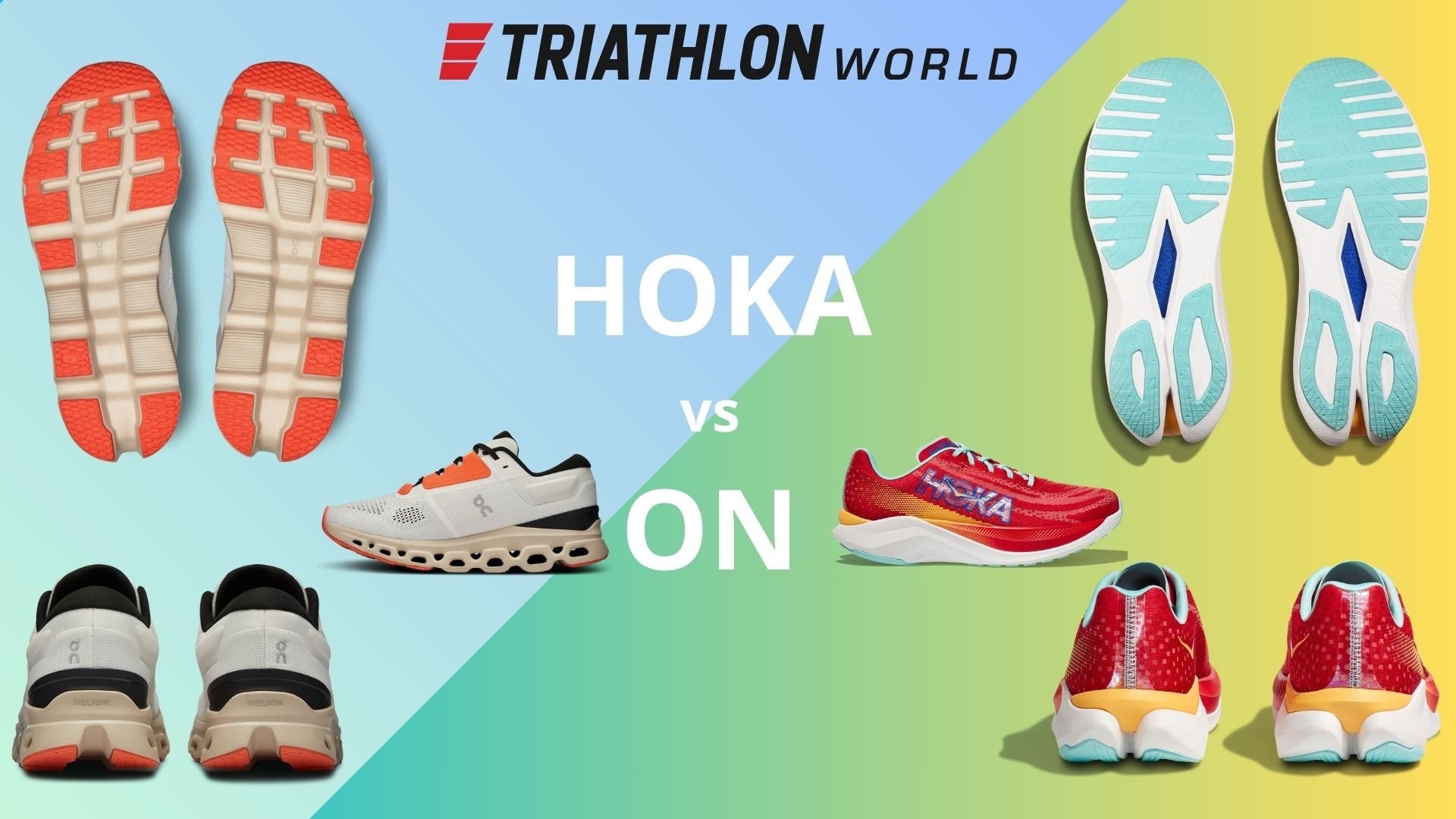
HOKA or ON RUNNING: The honest opinion of TriathlonWorld
, by Julian Spraakman, 7 min reading time

, by Julian Spraakman, 7 min reading time
In the world of running, where every step counts and every choice can make a difference, the shoes you wear are essential. In this blog, the TriathlonWorld team takes you through the differences between two of the most popular running brands at the moment; Hoka vs. ON Running.
In the world of running, where every step counts and every choice can make a difference, the shoes you wear are essential. With a plethora of brands and models on the market, finding the right balance between cushioning, stability and performance is a huge quest. Among the many options we as runners have today, two brands are at the center of the debate: HOKA and ON Running.
The rise of HOKA and ON Running caused a shift in the running world. A shift from traditional designs to innovative technologies that improve your running experience. Both brands take a unique approach to cushioning and stability, which has made them a favorite among seasoned athletes and recreational runners alike. In this blog we're going to explore the differences between HOKA and ON, from their sole technology to their fit and price points. Whether you are looking for maximum cushioning or improved stability. We take a closer look at the features of these two brands to help you find the perfect shoe for all your running adventures.
Before we start this blog, I want to be honest right away. Comparing running shoes can lead to heated discussions. People often have strong preferences for a particular brand, while others hate it. The debate between Hoka and ON Running is no exception. Both brands offer shoes with quirky designs that fit perfectly with different types of feet and runners.
Hoka and ON Running, founded in 2009 and 2010 respectively, have both ensured that you suffer less from hard shocks while running. Their philosophy is that a smoother run is a faster run, even if you sometimes sacrifice energy return. The brands' sole designs reflect this new philosophy, whether it's Hoka's marshmallow foam or ON's hollow pods.
Both brands have a shared philosophy, but that is one of the few similarities. After all, the differences are much more striking, will you join us in watching?

Hoka vs. ON: Midsole
With both Hoka and ON you can recognize the soles from a distance. At Hoka, a large part of the range has a 'marshmallowy' midsole with lots of EVA and PEBA foam.
Although they look full and bulky on the outside, Hoka's shoes are among the lightest we tested, despite all that foam padding under your feet. The high sole can feel awkward if you're not used to it, but it is easily one of the most comfortable running shoes available right now.
ON Running, on the other hand, uses a midsole that maintains a low weight by being largely non-existent. This has to do with the gaping holes in the sole of the ON running shoes. These hollow pods, which the brand calls the "Cloud" system, are intended to divide your run into two distinct phases: A landing phase, in which the pods compress and absorb shock, and a lift-off phase in which the pods snap into place and turning your sole into a sturdy platform for an energy-rich push-off. This design is therefore more stable than soles with uniform foam, because the pods can only be compressed in one direction.
Hoka vs. On: Geometry
When we look closely at the design of the shoe, we see two striking differences. At Hoka we see the so-called 'rocker' sole predominating in many designs. Rocker soles curve sharply upward from the midfoot to the toe for a smoother heel-to-toe transition. These 'rocker' soles can feel strange if you're not used to them and to some extent they can make you feel like you're constantly tilting forward. Hoka uses this weight shift mainly to relieve your ankles and calves when pushing off.
At ON, on the other hand, you are more likely to find traditionally shaped soles with a less tapered taper towards the front of the shoe. This ensures a less aggressive gait and a more neutral running experience. If you're looking for a more grounded feel from your shoes, ON's flatter, low-stack soles will feel more comfortable.
Hoka vs. ON: Damping
As we mentioned before, Hoka is a brand known for its thick midsole cushioning. However, Hoka makes shoes with three different levels of cushioning: ultra-soft, balanced and responsive. The ultra-soft cushioning is said to "minimize" impact, while the balanced cushioning returns more energy while running. Responsive cushioning is mainly found in Hoka's trail and racing shoes and actually provides "more resilience".
On the other hand, ON's shoes have their own CloudTec cushioning, which uses small cushions to reduce impact. According to experts, this provides a good balance between comfort and support. While ON is a comfortable shoe that feels cushioned, it doesn't compare to the heavily stacked cushioning found in most Hokas. On the other hand, we believe that ON shoes respond better and more directly because of the firmer sole.

Hoka vs. ON: Stability
Both ON and Hoka are brands that are not really known for making so-called stability shoes. The differences here are minimal. On the other hand, Hoka does make a number of shoes that are specifically designed for stability, the so-called J-Frames. J-Frames are designed for extra support and constructed from firmer foam, which is ideal for runners who overpronate.
Hoka vs. ON: Sustainability
Regardless of brand, running shoes are meant to be replaced every 600 to 800 miles. We can go on forever about how one brand is more durable than another, but eventually the technology and cushioning of any running shoe breaks down after a while. That said, based on our own testing, we experienced less durability with the Hoka's due to the soft midsole cushioning. Hoka's cushioning seems to compress faster than ON's less soft 'pods'.
Hoka vs. ON: Price
If you buy a pair of Hoka's, you will easily pay between €150 and €275 for your new pair of shoes. One of the most popular styles, the Bondi 8, costs around $170, which is comparable to other high-quality running brands. It will therefore not surprise you that the Hokas designed for fast competitions such as the Rocket X2 or the Cielo
ON's most popular model, the ON Cloud 5, costs around €140, which is slightly lower than Hoka's best-seller. However, ON also makes pricey racing shoes, such as the On Cloudboom Echo 3, which costs almost €300.
It's also worth knowing that you can find both ON and Hoka for less if you're willing to settle for a previous season's model.
Conclusion
To make a long story short. Both Hoka and ON make great running shoes. If you're someone who appreciates a firmer midsole with more responsiveness, ON shoes are an excellent choice. If you prefer thick stacked cushioning or want to try out a stability shoe, Hoka is your best choice.
And if you really have to choose between Hoka or ON, you can rest easy knowing that they both make high-quality running shoes. Many runners have now accepted this development and both brands have amazed our TriathlonWorld team with their running shoes.
We are happy to advise you in one of our branches or view our Hoka and ON Running collection here !
#FINDYOURBEST
[SPLIT]
blog-hoka-vs-onrunning-shoes